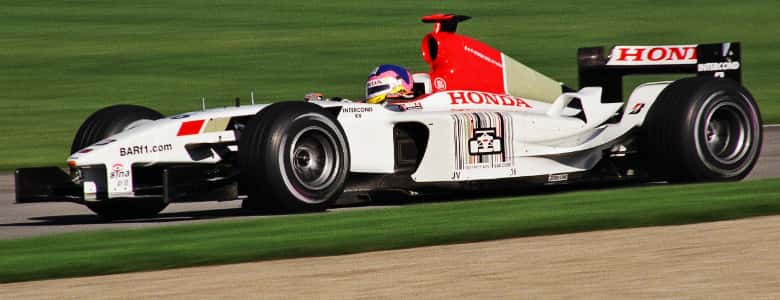One with Data

Nowhere is the need for speed more dramatic — and dangerous — than on the Formula One (F1) racetrack.
The cars, the crowds and the contest of champions all make for an adrenaline-charged motorsport that has captivated fans the world over for generations.
“A F1 car is part jet fighter, part automobile, part information technology system, and it’s all completely data driven,” said F1 Industry Executive Mark Gallagher.
Indeed, F1 drivers push 300 kilometres an hour in their mechanical speed demons, and a millionth of a second could mean the difference between victory or defeat.
Risk and reward hang delicately in the balance, and in recent years, technology — and yes, data — have raced to the fore as determinants of safety and performance.
Mr Gallagher was speaking at the RSA Conference Asia Pacific and Japan, held in Singapore from 26-28 July 2017.
Sharing the stage was Mr Jacques Villeneuve, who won the F1 World Championship title in 1997.
Together, they presented an intimate dialogue about the perils and pleasures of F1 racing — and how data has been the metaphorical engine under the bonnet of the entire motorsport franchise.
Data speeds up safety
To paraphrase Spiderman: With great speed comes great risk of catastrophe, and this was certainly the case in F1’s early days.
“Between 1950 [the year F1 started] to 1995, we had over 40 driver fatalities,” said Mr Gallagher. “This is a humbling statistic. Our management of risk back in those days was not what it should have been.”
Among these fatalities was Mr Villeneuve’s father — Mr Gilles Villeneuve, himself a legendary F1 racer.
During the qualifying round of the 1982 Belgian Grand Prix, a collision catapulted the senior Mr Villeneuve’s Ferrari through the air at an estimated 225 kilometres per hour, landing in a fatal crash.
While high speed accidents are always a possibility, F1 drivers should be able to emerge from the wreckage disappointed, but ready to race another day.
Today, data is informing the way engineers design and manufacture F1 cars to protect drivers in the event of disaster.
Because of data-driven engineering, shock-absorbing armour and fire suppression systems are now built into the cockpits of F1 cars.
“When Fernando Alonso had an accident last year at the Australian Grand Prix, audiences all around the world were wondering: is he going to survive? He was able to walk away from that and continue his career, because IT allowed us to reverse engineer vehicles to cope with the tremendous impact of a crash,” said Mr Gallagher.
Turbocharging driver performance
Beyond enhancing safety, data is also revolutionising the performance-monitoring ecosystem of F1 races. Instead of just drivers and mechanics, each race team now also deploys a slew of data analysis engineers.
“You would have about ten engineers, all looking at computer screens analysing everything,” Mr Villeneuve remarked.
If that sounds like an unreasonable number of supporting actors in a play, Mr Gallagher is inclined to think otherwise.
Each car generates approximately 80 gigabytes of data per race, from 280-300 sensors that report on vehicle performance and the inputs of the driver in real time.
Making sense of all this data could give the driver a much-needed edge.
“What we’re really interested in are the anomalies, the things that go outside their normal performance parameters — systems that are degrading, or perhaps something the driver is doing that we want to change,” said Mr Gallagher.
Data is also bringing F1’s newer faces up to speed with the competition in terms of race preparation.
Red Bull’s race simulator has been partially credited with 19-year-old Max Verstappen’s meteoric rise on the F1 circuit. Using actual data from races, the simulator allows a driver to test drive any racetrack in the world, under any circumstances.
“You can train the driver to cope with risk in terms of accidents and pit stops, or drive under different weather conditions. It becomes the ultimate training tool!” Mr Gallagher exclaimed.
Driverless F1?
Although data and technology have helped F1 flourish, there have been concerns among fans that the human element of racing is being eroded.
Moreover, with the advent of automation and artificial intelligence, speculation is rife that human racers may one day be obsolete.
However, Mr Gallagher and Mr Villeneuve both expressed scepticism that F1 will eventually be reduced to a sport of autonomous vehicles driving laps around a circuit. In fact, they think that as technologies become more advanced, the human factor will keep races exciting.
“A driver who is capable of feeling the car and explaining it to the engineers will shine even more now,” said Mr Villeneuve.
He argued that while computers can come up with the numbers for a perfect performance, this matters little if it means that the car needs to be configured in a way that is incompatible with the driver.
Mr Villeneuve also noted that at the end of the day, F1 racing is a spectator sport, and personalities are as important as speed on the racetrack.
“Sure, you could get to the point where a driverless car is faster than human-driven cars. But then who would watch that? You only have racing if you have fans watching it, because it’s very expensive, and for the sponsors and manufacturers to come in, you need to have heroes and gladiators.”
Photo credit:
- Main image (top photo): Creative Commons Villeneuve BAR USGP 2003 by Rick Dikeman licensed under CC BY-SA 3.0.
- Photo of 2005 Canadian Grand Prix: Creative Commons Jacques Villeneuve 2005 Canada 2 by Mark McArdle licensed under CC BY-SA 2.0.
- Teaser image: Creative Commons Jacques Villeneuve 2005 Canada by TMWolf licensed under CC BY-SA 2.0.

